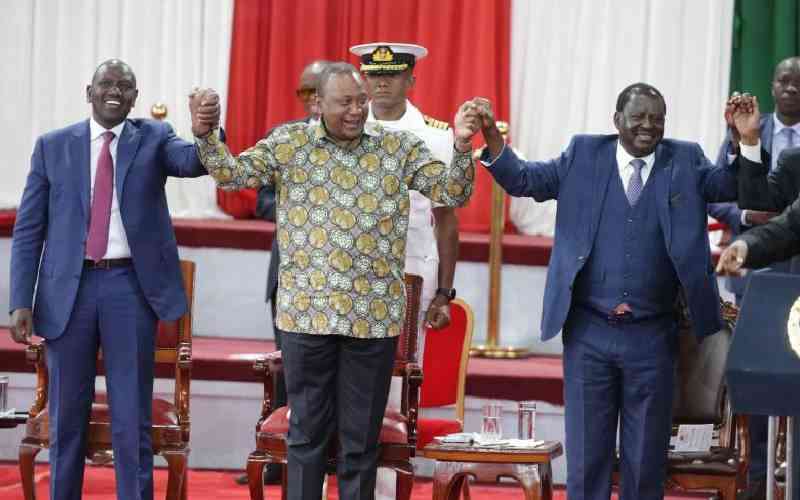After a year that began on the wrong footing due to divisions over the hotly contested and controversial 2017 presidential polls, 2019 could bring with it better economic growth prospects.
Among the key issues that could shape economic conversations and the lives of Kenyans this year are whether a law on interest rate caps will be repealed, the national census, a new currency, and the political climate.
This positive outlook could, however, be affected by the high-octane politics that is gaining momentum - specifically a referendum and 2022 succession politics that could hamper the country’s economic growth.
But with the World Bank having projected Kenya’s economy to hit 6.01 per cent this year from 5.475 per cent recorded in 2018, the Government is upbeat about the oncoming economic prospects.
“Our growth outlook at around six per cent remains stable and so are other macroeconomic indicators like inflation, interest rates, and the currency exchange rates,” Treasury Cabinet Secretary Henry Rotich told Financial Standard.
“We will continue to monitor the global developments especially trade wars, Brexit, commodity prices and US monetary policy and take appropriate actions to mitigate any negative consequences to our growth,” he said.
Since Uhuru Kenyatta became president, the highest rate at which Kenya’s economy has grown in a year was 5.9 per cent in 2016 and 2013, when Mwai Kibaki retired.
Remittance inflows
This year’s growth could be supported by strong remittance inflows and rising household income from agriculture and lower food prices.
“Manufacturing is still recovering and its activities remain sluggish. The sector growth rose from 0.5 per cent in 2017 to 2.7 per cent in 2018, but still remains weak compared with a three-year average of 3.6 per cent over 2013 to 2016,” said the World Bank recently.
Among the key drivers of growth this year will be an improved business environment as well as the easing of the political climate, underpinned by strong agricultural output and a good performance by the service sector.
Further, the Bretton Woods institution projects that with interest rates capping and banks leaning towards government securities, credit is unlikely to grow, especially for small enterprises.
This view has also been shared by the Central Bank of Kenya (CBK) which has consistently said that the ceiling on interest rates charged by banks was denying entrepreneurs access to credit which is stifling economic growth.
However, according to a survey released last week by research firm Trends and Insights for Africa (Tifa), four out of 10 Kenyans, or 44 per cent of would like to set up a business next year while 32 per cent will be scouting for jobs
The drafters of Vision 2030 had insisted that for Kenya to be a medium income economy, its GDP was supposed to grow by more than seven per cent annually for two decades.
Stay informed. Subscribe to our newsletter
If the political environment remains stable, Kenya’s economy will for the first time in a decade hit a six per cent growth rate in 2019. Industry leaders are however afraid that all this could be wiped out by the unpredictable operating environment.
“2019 promises to be a strong year for the sector, specifically if the predictable and stable business environment can be guaranteed in policy formulation and implementation,” Kenya Association of Manufacturers Chief Executive Phyliss Wakiaga told Financial Standard.
On the bright side, previous economic growth numbers show that Kenya’s economy has in the last two decades grown its fastest in the second year after a presidential election.
The growth, however, starts to decline in the third year as another election approaches.
In 2004, just a year after Mwai Kibaki had been elected as president Kenya’s economy grew by seven per cent. In 2010 it rebounded to 8.4 after the peace deal between Kibaki and his political nemesis Raila Odinga in the 2007 elections that led to the grand coalition government.
Then in 2015, year after Uhuru had been elected for his first term it hit 5.9 per cent. Thanks to the handshake between Uhuru and Raila, Kenya’s business climate has stabilised, though still struggling in some sectors such as mining which remains on the growth path.
The retail sector which has had one of its worst years leading to the downfall of two key retail giants; Nakumatt and Uchumi has started showing signs of rebounding.
With 391,000 square metres of lettable retail space, Nairobi still holds the crown as having the most shopping space in the continent outside of South Africa. The entry of Africa’s largest retail chain, Shoprite in March shows that Kenya is still a sweet spot for retail investment in Kenya.
The retailer has in just nine months, Shoprite has increased its presence in Kenya to four stores, with three more set to be opened by the end of the first quarter of 2019.
 The Standard Group Plc is a
multi-media organization with investments in media platforms spanning newspaper
print operations, television, radio broadcasting, digital and online services. The
Standard Group is recognized as a leading multi-media house in Kenya with a key
influence in matters of national and international interest.
The Standard Group Plc is a
multi-media organization with investments in media platforms spanning newspaper
print operations, television, radio broadcasting, digital and online services. The
Standard Group is recognized as a leading multi-media house in Kenya with a key
influence in matters of national and international interest.
 The Standard Group Plc is a
multi-media organization with investments in media platforms spanning newspaper
print operations, television, radio broadcasting, digital and online services. The
Standard Group is recognized as a leading multi-media house in Kenya with a key
influence in matters of national and international interest.
The Standard Group Plc is a
multi-media organization with investments in media platforms spanning newspaper
print operations, television, radio broadcasting, digital and online services. The
Standard Group is recognized as a leading multi-media house in Kenya with a key
influence in matters of national and international interest.








